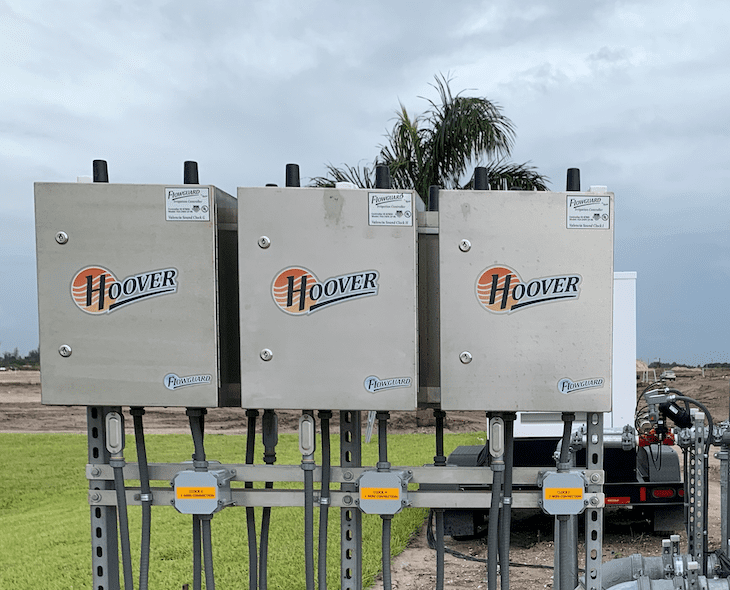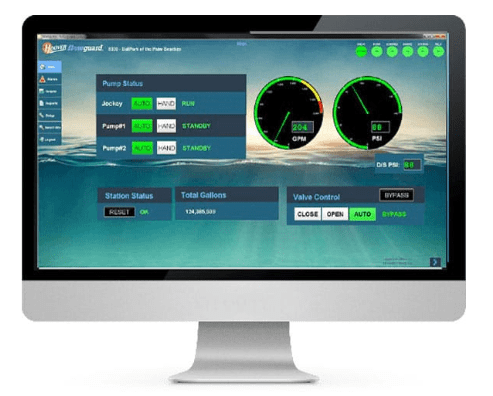
With automatic irrigation, the irrigation occurs at the times set - irrigating the landscape on a pre-set schedule with a pre-set volume of water at specific times and in specific places. It remains set until manually changed.
Smart irrigation is a term used to describe systems that irrigate according to the needs of the landscape, using data about humidity, rainfall, soil moisture content and plant water usage to constantly calculate and calibrate watering schedules according to need. In other words, the water distribution and the amount of water required is determined using the data collected and is constantly monitored to match changing needs.
Why should you be interested in smart as opposed to simply “automatic” irrigation? If you’re not a professional in the field or a farmer with crops which need irrigating, then the technicalities of matters such as centralized control, irrigation data collection and 2-wire decoders may seem too complex to spend a lot of time thinking about. In some parts of the world this may feel like it makes perfect sense, but if you live in Florida then irrigation, in general, is something which you have to think about whether you like it or not.
The Florida climate is famously unpredictable, boasting huge shifts between different parts of the year and regions of the state, and often switching from torrential downpours to periods of drought at little or no notice. The kind of extreme weather that the climate in Florida can throw at the people living there was demonstrated in stark terms in 2020. Back in April daily temperatures in Miami were climbing as high as 95 degrees, as opposed to the seasonal average of 83, and the month as a whole was the hottest on record, following the second-warmest March ever. In fact, the start to the year as a whole in Miami had been the hottest since records began to be kept 83 years ago.

Not that this blistering start to the year was confined to Miami. Between mid-March and mid-April 2020, the temperatures recorded in almost the whole of Florida were the hottest on record – Orlando recorded a hundred-year record high of 97 degrees, while Daytona Beach hit 94 and Melbourne 96-degrees!
Climate extremities of this kind are the reason why every business and resident in Florida has to spend at least some time thinking about the need for irrigation, or at least they do if they want to maintain the kind of vibrant and appealing plant life which helps to make the state such an appealing place to live, work and visit. So if irrigation is a necessity (and it is), then the question which arises is how to get the job done in the most efficient manner possible. Answering this question involves an understanding of the advantages which smart irrigation offers over the manual and automatic options, particularly when the latest innovations in the field are taken into account.
Those advantages include the fact that having a smart irrigation system installed actually means having to spend much less time thinking about the irrigation of your lawns and plant life. This may sound counterintuitive, but it recognizes the fact that the smart irrigation system, once it’s been installed, does the thinking on your behalf. When you consider the savings generated by the efficiency of smart systems it begins to sound like a fairly irresistible combination, but perhaps the greatest advantage offered is the massive reduction in water waste.
According to the United States' Environmental Protection Agency (EPA), outdoor water use accounts for 30% of household water use across the whole of the country, rising to 60% in arid regions. Watering the average sized lawn for 20 minutes 7 days a week is the equivalent of taking over 800 showers (that's the number taken by the average-sized family in a year), and over 50% of the water used outdoors is generally lost due to factors like wind, evaporation and runoff. It should be noted that this last figure – on the amount of water wasted – applies to inefficient irrigation methods and systems. According to the EPA, a well-managed and maintained irrigation system can reduce water use by as much as 15%, which represents 7,600 gallons of water every year.
So that deals with the ‘why’ of smart irrigation – it increases efficiency which saves on water and the cost of irrigation, it reduces the time and expense of the maintenance of a system and it maximizes the impact of the irrigation itself. What actually needs explaining is what smart irrigation actually entails and the advantages it offers over automatic irrigation. To people used to dealing with traditional irrigation systems, the phrase ‘automatic irrigation’ will conjure up images of sprinklers which can be set to turn on and off at specific times during the day; but a modern smart irrigation system takes the application of technology to a very much higher level than this.
A centralized control system can work for an individual property or a large grouping of properties. In the latter case, it offers the managers of that group of properties a huge up front capital saving and much lower burden in terms of ongoing maintenance issues. Smart irrigation doesn’t simply mean handing control over to the system itself, however, since a control unit which utilizes technology like Hoover’s Flowguard system gathers data on all aspects of the operation of that system, and makes that data freely available. From a single dashboard, accessed from the widest possible range of devices, users can monitor information such as water usage on an ongoing basis, rather than having to wait for a site visit and meter reading.

Making data such as overall water usage available to end-users is clearly useful, but it only scratches the surface of what a truly smart irrigation system is able to offer. The amount of data which a system of this kind can gather is huge, but of even more importance is the way in which this data can be used. Reports can be compiled and published, creating a record of the operation of the system and the irrigation solutions it offers. Even more usefully, massive amounts of data on all aspects of the system can be gathered and analyzed using the leverage offered by cloud computing. In this way, a smart system, rather than the automatic option of being set and then monitored periodically to see if a re-setting is necessary, can tweak and alter itself in response to the data it is delivering, in real-time and on an ongoing basis.

When truly smart irrigation systems are installed, each becomes part of a much larger network of similar systems, and the data from all of these systems can be combined and analyzed in order to continually improve the irrigation solutions being delivered. What this means is that the system constantly evolves in response to the data, whether that means data on the weather conditions or on how the mechanics of the system – pumps and sprinklers etc. – are functioning.
The control systems rely on information delivered by sensors which make up part of a smart irrigation system. In simple terms, there are two types of sensor – those which monitor weather information to calculate evapotranspiration (ET) rates (basically a measure of how much water is lost from the soil and plant surfaces through evaporation), and soil moisture monitors which report back on soil conditions from key areas such as the root zones of plants. The control system in a smart set-up takes all of this data and uses it to make any adjustments needed to the amount and timing of the water being delivered.
A smart irrigation system is much more than simply a set of smart sprinkler heads controlled by timers. It is a fully integrated system which utilizes the power of data analytics and cloud computing and combines it with 21st-century engineering to deliver a total irrigation solution, saving you time, water and money and delivers optimum results.